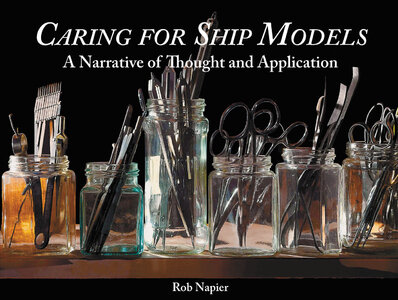
Rob Napier. Caring for Ship Models, A Narrative of Thought and Application.
Seawatch Books LLC
www.seawatchbooks.com, Maplewood, NJ 07040
ISBN 979-8-9862370-0-8
186 pages.
Most are familiar with scale model ships, whether they be from personal collections or from important institutional collections such as the Thompson Collection at the Art Gallery of Ontario in Canada, the collection of the US Naval Academy Museum in the U.S.A. or the largest collection in the world of scale model ships at the National Maritime Museum in the U.K.. On the other hand, few are probably familiar with those who maintain these important historic objects. From their regular care and conservation to in some cases full restoration of models that have fallen into bad disrepair.
Rob Napier is one of those unique individuals and through his book Caring for Ship Models, A Narrative of Thought and Application, Napier provides the reader with a deep insight into the world of model conservation/restoration based on his experience.
This book is broken down into four sections. The prolog in which Mr. Napier provides the reader with a brief background into his history working with ship models, as a model builder, repairer, restorer and conservator throughout his career.
In the second part of the book Mr. Napier provides the reader with his personal perspectives on working with ship models. Thus, giving the reader an understanding of how and why he approaches each project, and what his primary initial goals are when looking at models.
Part three of the book is really the heart of the book for those interested in the How-to business of repairing models. Napier takes you through the process he uses to evaluate potential commissions supported by his reasoning for doing so. He further discusses the tools and equipment he uses and in cases where they don’t readily exist discusses some of the forms he creates to conduct his repairs.
In the last section of the book Napier provides 29 case studies of various influential projects he’s work on in his career. Each study starts with some background information about the model and its builder. It then goes into his observations of the repairs needed and then describes how he approached each repair.
This book is very well laid out and written, with a large number of reference images throughout the book and will be of great interest to not only modelers wishing to take care of their own models but also other conservators and restorers of models.

